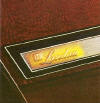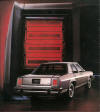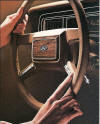
The Complete "Box" Panther History
Quick Links
1979
1980
1981
1982
1983
1984
1985
1986
1987
1988
1989
1990
1991
Complied by
Tiggie
Copyright 2008, Grandmarq.net
Thanks to all who help make this collection of information possible, please check here for contributors.
1979
The new “Panther”
platform was introduced for Ford and Mercury. It was produced in
Oakville, Ontario and St. Louis, Missouri. Although its wheelbase
was seven inches shorter than the preceding platform, it offered more
trunk and passenger area than its predecessor while weighing approximately
700 pounds less. The new Panther models were christened the Ford LTD
and Mercury Marquis and were not related to the mid-sized LTD II in any
shape or form. The outgoing “barge” LTD’s eight-model lineup
continued into the new “box” LTD’s. Literature boasted 0-60 times in
10.2 seconds, making it only a second and a half behind the times of a
1979 Mustang Cobra.
1979 models have numerous unique features. Some of these include a V-Belt pulley drive system, a center mounted front tag, and unique roof and lighting treatments. Much of the interior trim has unique features, separating it from later years. LTD Landau models received clear parking light lenses which are highly sought after as retrofits for later models. The rear tag "bucket" was also chrome plated on LTD Landau models.
A feedback variable venturi carburetor, the Motorcraft 7200VV, was used to deliver excellent fuel mileage on models equipped with the 302 (5.0L). It used Electronic Engine Control (or EEC)-II with a microcomputer control unit (MCU) to control fuel delivery. Depending on engine and destination, the more traditional Motorcraft 2150 carburetor occasionally replaced the 7200VV, almost always on 351W (5.8L) and export units. Due to it's unique, often misunderstood design, many 7200VV carburetors have been replaced by the Motorcraft 2150 or direct replacement Holley 2-bbl models.
1980
Substantial model name
changes came for the 1980 Ford Panther line:
-
A new value-leader LTD S model debuted, roughly equivalent to a low-option 1979 LTD. Initially available as only 4-Door Sedans and Wagons, 2-Door LTD S models were later added and are thus quite rare with only 553 models being produced. All LTD S models are easily identified by their two headlights (versus four for the higher priced models);
-
The LTD model name remained unchanged, but did gain some standard features (all previously optional). These features included woodtone interior appointments, additional sound insulation, styled remote driver's mirror, bright window and hood edge moldings, decklid accent stripes, brushed accent panel on the lower decklid, trunk side linings, and four headlights;
-
The 1979 LTD Landau model became the 1980 LTD Crown Victoria;
-
Wagon names remained unchanged, although an S-model was now available;
-
Mercury model names remained unchanged.
The Automatic Overdrive (AOD) transmission debuted as on option on the Ford and Mercury. Mercury model names remain unchanged. Sales plummeted over 100,000 units, due in part to a slump in the economy. Mercury taillights changed slightly; the previously body colored portion between the tag and the taillights was now black.
Lincoln began offering its Continental and Mark line on the new Panther Platform, resurrecting the 1958-60 practice of fielding two versions of the same basic car. While each line retained some of the styling cues of the previous models, they did not retain their big-block engines. Standard was the 302 in the new electronic fuel injection form, while the 351W was optional and still carbureted. The electronic fuel injection system (EFI) used a centrally located throttle body with two fuel injectors, looking similar to a carburetor at a glance. It was dubbed Central Fuel Injection (CFI) and used EEC-III to function. The AOD was standard on the Lincoln line. The Lincolns rode an extended 117.3 inch wheelbase, except for the two-door Mark VI which rode the same 114.3in wheelbase as the Ford/Mercury line. This was the year of the first ever four-door Mark-Series. Concealed headlamps (with auxiliary headlamps optional), unique exterior trim pieces, and distinct roof treatments set the Mark VI apart from the standard Continental. All Lincolns were produced at the Wixom, MI plant.
A standard Continental two-door could be nearly as well dressed as a Mark VI with the $1089 Town Coupe roof and $396 Turbine Spoke wheels. Standard Continentals started at just $12,555, while Signature Mark VI’s started at $20,940.
The new Signature Series Mark VI’s had the option of the $2809 Bill Blass Edition, highlighted by carriage-style white vinyl roofs, turbine spoke wheels, and “loose-pillow” leather. CB radios were available at $356. Electronic Instrumentation could be deleted for a $707 credit. Pucci, Bill Blass, Cartier, and Givenchy designer models were also available.
The optional electronic instrumentation on the Lincoln models included a trip computer. This computer calculated fuel economy, average speed, and distance traveled. The Ford and Mercury cars would receive a similar computer in 1982.
This year was possibly the last time Ford literature referred to the high-performance of a Panther-Platform car. This was the only year when a LTD and V8 Mustang race would be equal, each pulling 0-60 in just over 10 seconds. The weight difference was made up by the LTD’s 351W, while the Mustang (Cobras included) made do with either a 255 (4.2L) V8 or turbocharged 2.3L. The end of the LTD performance was soon to be at hand, while the beginning of Mustang performance was just beyond the horizon.
1981
In light of fuel
economy requirements, the 255 debuted as standard equipment on
non-California sedans. The 302 became a $42 option on non-CA sedans,
alongside the 351W in the Ford and Mercury Panther lines. The 255 was
available only with the AOD, while the 302 and 351 continued to to come
standard with the C4 and AOD optional.
On the Ford and Mercury, integrated aerodynamic side mirrors were replaced by traditionally mounted units. The Colony Park lost its fender vents, other Mercury models would continue with them for another year. The front bumpers were changed to eliminate the air ports across the model line, except for the Continental Mark VI.
Lincoln changed it’s naming system to avoid confusion this year. The standard Continental became the Town Car and the Continental lived on in the Continental Mark VI. On the Mark VI model, Bill Blass, Cartier, and Givenchy packages could have been added for the sum of $2160 to $3015. The Town Car received an updated grill without the Continental nomenclature attached. Signature Mark VI’s continued to receive special features not available on other Lincolns. Signature-Series Town Cars appeared for the first time as well, but they did not get the special amenities of the Signature Mark’s.
There is confirmation of Mercury offering a police-prep package until this point. 1980 and 1981 versions have surfaced. The unique part different from the Ford police package is the speedometer, listed under part number E1MY-17255-C; applications are listed from 1980-82.
1982
The "tripminder"
appeared this year for the Ford and Mercury cars. It was an in-dash
computer optional on the Ford and Mercury lines. Using input from
the speed sensor and fuel flow sensor, it was able to calculate fuel
economy, distance traveled, average speed, and the amount of fuel used in
addition to keeping track of the month, date, time, and elapsed
time. The tripminder measured in English as well as Metric
units.
The LTD speedometer also changed – the previously orange needle and secondary speed numerals changed colors: the speedometer needle went to white and the secondary numerals to blue. This scheme would be used through 1987.
In the drivetrain department, the 351W was now standard in the police models, but unavailable to the general public except for those living outside the U.S. To meet the tightening federal fuel economy requirements, the 255 was tuned to deliver 18 city/26 highway MPG. The 7.5 rear axle was deleted from the line, with the previously optional 8.5 becoming standard. The ratios available were 2.47, 2.73, 3.08, and 3.42. The AOD became standard equipment on all models.
In 1982, the entire Ford line was reintroduced to the traditional Ford Blue Oval, making its way onto the LTD’s grille and trunk lid. 1982 LTD’s have a unique grille. It was basically identical to the previous year’s, but with the addition of the blue oval. Strangely, the blue oval didn’t make it to the center of the steering wheel until 1983. Mercury cars lost their fender vents; the Mark VI kept its vents and would continue to keep them until its demise.
Light blue and green interiors were no longer available. This was the last year of white leather with red, blue, or tan appointments on the LTD Crown Victoria.
The two-door Lincoln Town Coupe was cancelled, but the two-door Lincoln lived on in the Mark VI. Designer Lincoln models were now considered separate models, with Pucci being added to the Mark and Cartier being applied to the Town Car.
Also of interest, the Continental name was applied to a modified Fox platform and no longer based on the Panther platform.
1983
Nomenclature changes
abounded this year. A mid-sized Ford LTD and Mercury Marquis
(basically a reskinned Fairmont) took over for the Granada and
Monarch. Since two models with name would be illogical, the Ford and
Mercury Panther lines were completely renamed. Anything LTD in 1982
was now LTD Crown Victoria in 1983. In the Mercury line, anything
Marquis was changed to Grand Marquis. The nomenclature change also
eliminated the “S” as a separate model line. Lincoln changes were
limited for 1983. So-Called “Two-Headlight” LTD’s creased to exist;
the four headlight model was now standard.
The 255 V8 was dropped, the venerable 302 again returned as standard equipment across the Panther line. Central Fuel Injection (CFI) replaced the infamous Variable Venturi Carburetor as standard equipment on the Ford and Mercury Panther lines in the US. In other markets such as Canada, the carburetor continued on. An “eggcrate” grille was now standard in the Crown Victoria line, while the Grand Marquis also received a revised grille. Taillights were changed on both Crown Victoria and Grand Marquis models; Crown Victoria’s no longer had LTD in the taillights, the Grand Marquis eliminated black-out panels between the tag and taillights.
Inside, vinyl steering wheels replaced hard plastic ones. The aluminum decorative trim located on the sides of the front seats was deleted. The premium sound amplifiers moved to the trunk from the center of the dash.
1984
EEC-IV debuted on the
CFI 5.0L (302) in the Ford, Mercury, and Lincoln lines and the engine
received and additional 10 horsepower. The police 351W also picked
up a few horses on paper, going from 165 to 180. The AOD received a
new valvebody design, for which aftermarket shift kits are available
for.
Ford had now recovered almost all tooling costs for anything based on the Panther platform and each unit that rolled out the door was highly profitable.
Gas-Pressurized shocks became standard in the Lincoln Town Car.
The Mark VII series began. Based on a Fox platform, it replaced the Panther platform-based Mark VI. The Town Car was now the only “Big” Lincoln, with standard, Cartier, and Signature trims available.
1985
Crown Victoria/Grand
Marquis production began at St. Thomas.
Horn buttons were moved from the turn signal switch to the center of the steering wheel for all models of Panthers. Steering wheel mounting was changed, although mostly invisible to the average person. Ford and Mercury received gas-pressurized shocks as standard equipment. Self-Leveling rear suspension also showed itself for the first time in the Ford and Mercury stables.
The radio line was revamped. All radios now fit into a single, smaller opening. Analog radios were adjusted to fit this opening and electronic units were downsized. The 8-Track and CB were no longer options. A twelve speaker, 140-watt JBL premium sound system was available in the Town Car, with CD player being optional on top of that.
Climate Control faces were modified appearance wise this year. Wagons received an anodized aluminum front bumper to go with the anodized rear bumper the wagons had carried since production began. "Automatic Overdrive" or "Electronic Fuel Injection" emblems were removed from the lower front fenders. A federally mandated third brake light was added to all Ford, Mercury, and Lincoln vehicles very late in the model year.
Lincoln slightly revised the exterior styling slightly. Corners were basically rounded for what was then deemed an “aero” look. “Waffle” grilles replaced the previous “Waterfall.” Uplevel Signature and Cartier models now come standard with premium sound systems, illuminated entry, and power mirrors. Carpet inside the cabin also became thicker.
1986
Sequential Electronic
Fuel Injection (SEFI) became standard across the board (including police
and Canadian models), as did 15 inch wheels and tires. The 351W was
now optional on the police models, still sporting its carburetor and MCU
setup similar to 1982 models. On the Crown Victoria/Grand Marquis,
the supply finally dried up of dash pads with the center grille (used for
single-speaker AM radios or a vent for the premium sound amplifier, now in
the trunk).
Roller camshafts and lifters (and compatible blocks) replaced flat-tappet versions in the 5.0L, although the technical specs of the camshaft remained the same.
The Throttle Valve linkage to the transmission used a unique, one year only design. This design is said to be a better design than that of the 1987-1991 models (which commonly have issues with the grommet breaking at the throttle body, quickly resulting in transmission damage).
1987
An electronic clock,
tinted glass, and air conditioning became standard on everything but Ford
fleet models (these features could be deleted for credit). The Crown
Victoria LX debuted, with a new model number in the VIN to match
(74). The “S” once again was its own model (72). Mid-year, air
vent designs on the dash were changed from vertical-only to a crosshatch
pattern on the Crown Victoria’s. Grand Marquis’s got updated dash
trim.
Beginning this year, especially on models bound for California, a yellow "Check Engine" light appeared on the instrument cluster, replacing the "Check Oil" light. It is not common.
1988
Two-Door Panthers were
now history. New “Aero” styling changed the looks of the front and back of
the Crown Victoria and Grand Marquis slightly (wagons did not get the aero
treatment in the rear). The LTD emblem was almost ready to rest,
being deleted from the turbine wheel center caps, a Ford Blue Oval on a
silver background or a Mercury Emblem on a black background replaced the
red background LTD emblem. Oddly enough, a revised LTD emblem showed
up in a new area, the new hood ornament. On the inside, a slightly
revised, easier to read speedometer appeared along with a minor changes in
dash (air vents were now the color of the interior instead of
black). On the Ford models, door panel trim on models equipped with
the Interior Decor Group changed (wooden-look lower armrest trim replaced
previously interior colored). Ford and Mercury Wagons once
again received aluminum bumpers all around (anodized in the rear, chrome
plated in the front). Sedans began using an aluminum inner bumper
structure, with certain sedans also receiving a chrome plated aluminum
outer shell instead of steel.
Lincoln achieved model year sales of over 200,000 for the first time ever and received a mild facelift consisting of a grille change.
1989
The Town Car received
amber parking light lenses, along with unique headlight surrounds with
blackout trim between them.
Early in the model year, all Panther's finally received a Check Engine Light. Every 1989 Ford and Mercury Panther I have seen has had a check engine light if equipped with the 5.0L. Oddly enough, Lincoln lagged behind, as I have seen several 1989 Town Cars without the "Check Engine" light.
1990
The entire Panther line
received drivers’ side airbags, rear shoulder seatbelts, and a tilt
steering wheel standard. This went along with a completely updated
dash and speedometer. The Crown Victoria and Grand Marquis used a
similar speedometer. The Crown Victoria had a black background and
the Grand Marquis used silver. Unnoticed to an average driver, the
floorboard/firewall design was changed. Crown Victoria/Grand Marquis
front door speaker grilles changed design slightly. Crown
Victoria/Grand Marquis Turbine wheels began to use argent coloring instead
of charcoal. The tripminder was no longer an option on Ford or
Mercury models – it didn’t fit into the new dash design. Power
windows and locks, along with the deluxe armrests with ashtrays were made
standard on all models.
The 351W police/Canadian Crown Victoria’s switched “throttle valve” setups, finally moving away from the rod actuated system.
The Lincoln TC received its true “Aero” styling with a dramatic makeover. An orphan that doesn’t belong, it is the only so-called "Aero" Panther without a 4.6L powerplant.
1991
The last of the boxes
rolled off the assembly line this year. Clear parking light
lenses on the Crown Victoria appeared for the first time since 1979. Less
than 4% of this year’s Full-Sized Mercurys were wagons.
The 351W police models still utilized their variable venturi carburetor and MCU with EEC-II technology from 1979. It is rumored that the 351W police Crown Victoria was the last American mass-produced car with a carburetor.
The true “Aero” Crown Victoria and Grand Marquis arrived mid-year with 4.6L power plants. Only a four-door sedan was offered. No more wagons, two-doors, and no more "box".

1979 LTD Landau
Roof Lighting

1979 LTD Landau

1979 LTD Wagon

1980 LTD

1979-1981 Ford
LTD Speedometer

1980 Country Squire
![]()
1980 Grand Marquis

1980 Mark VI

1981 LTD Crown Victoria

1983-1987 LTD Crown Victoria Grille

1983-1987 LTD Crown
Victoria Taillights

1983-1984 LTD Crown
Victoria Steering Wheel

1983 Grand Marquis

1984 Grand Marquis

1985 LTD Crown Victoria

1986 Grand Marquis and Colony Park

1988 LTD Crown Victoria LX Interior

1989 LTD Crown Victoria

1989 Town Car
![]()
1990-1991 LTD Crown Victoria Dash













